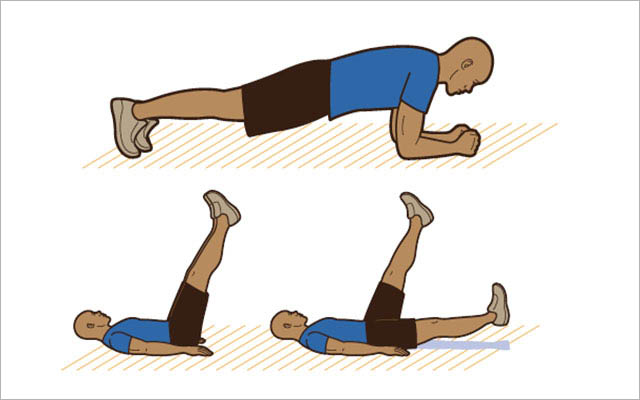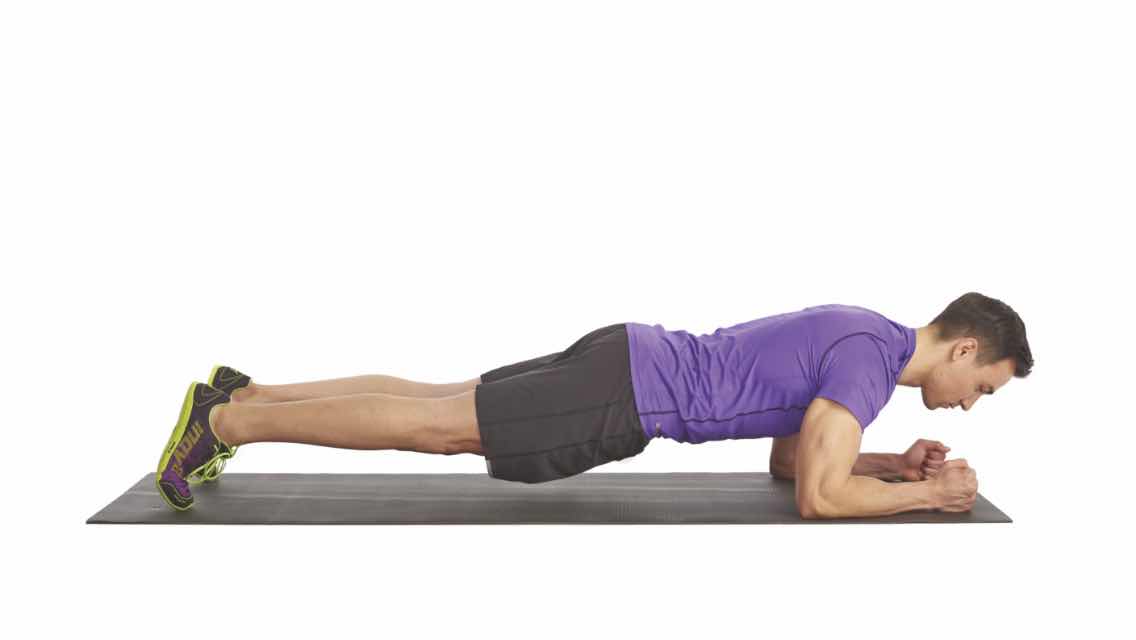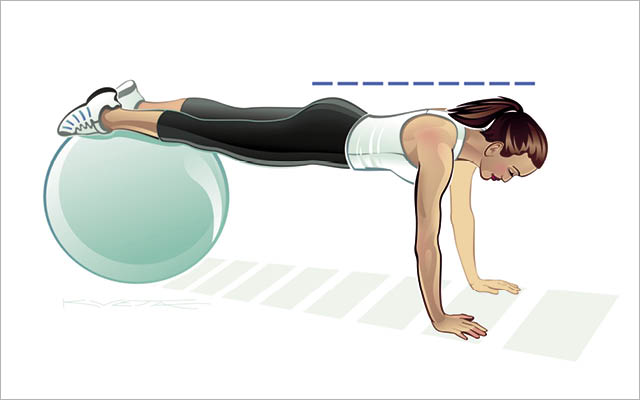Considering that abdominals are a relatively simple group of muscles, it’s amazing how much effort we put into optimizing them. From performing hundreds of daily crunches to trying the latest can’t-fail ab gadget, there’s a long list of methods for training your midsection.
While there is little consensus among trainers when it comes to naming the single best ab exercise, it turns out that a handful of winners get consistent kudos.
A much-publicized 2001 study at San Diego State University shed light on the top three exercises and also helped elucidate why they’re so effective. Peter Francis, PhD, a researcher in the school’s Biomechanics Lab, set out to identify the best ab exercises based on the amount of electrical activity generated in the abdominal muscles during selected exercises. Since electrical activity is an indicator of how much a particular muscle is working during an exercise, the greater the electrical activity (as measured by electromyography), the more rigorous the exercise.
Thirty men and women with varying degrees of training experience performed 13 common ab exercises – some without equipment; some with common gym equipment, such as an exercise ball and captain’s chair; and some with equipment more familiar to late-night television viewers (think Torso Track, Ab Roller and Ab Rocker).
The highest-rated exercise was the bicycle maneuver, followed closely by the captain’s chair and then the exercise ball crunch. These exercises produced the most electrical activity in three key abdominal regions: the external obliques, and the upper and lower rectus abdominis (see the “Ab Anatomy” sidebar). It should be noted that while the exercise ball crunch didn’t generate as much electrical activity in the obliques and the rectus abdominis as the other two, it did do a better job of isolating the ab muscles. Perhaps not surprisingly, the infomercial products did not live up to their promoters’ claims.
Maximal Maneuvers
According to Myatt Murphy, CSCS, author of The Body You Want in the Time You Have, it’s no surprise to find the bicycle maneuver at the top of the list. Because it combines lower- and upper-ab movement along with a twisting motion, it works the rectus abdominis from top to bottom and also engages the internal and external obliques. “A certain amount of instability is introduced with the side-to-side movement of the legs,” explains Murphy. “The body is forced to recruit stabilizer muscles while the rectus and obliques are working.” In essence, the bicycle maneuver is a complete, self-contained ab workout – no equipment required.
The captain’s chair is effective because it isolates the abs by providing back support during the exercise, and it effectively forces the lower abs to work directly against gravity. “Most ab movements that focus on the lower abs by drawing the knees toward the chest do so from a prone position,” Murphy says. “The resistance from gravity is diminished by the position of the body. During the captain’s-chair exercise, with its upright position, the knees are always moving directly away from the floor and battling gravity, which places the greatest amount of stress possible on the lower abs.”
The exercise-ball crunch combines the ab-isolating effectiveness of the traditional crunch with the enhancing benefits of an unstable surface. “The ball crunch is the fundamental exercise of core training,” notes Murphy. (See “Core Values.”) “Aside from actively isolating and engaging the rectus abdominis and obliques during the movement, the smaller, deeper muscles of the core have to fire constantly to keep you centered and on the ball. Mastering this move prepares you to move on to other core exercises with confidence.”
No Cheating
Without disciplined attention to form, even the best ab exercises can turn pointless in a hurry. The two major obstacles most likely to thwart your ab efforts: hip-flexor muscles and momentum. Here’s how to minimize their influence:
Hip-Flexor Muscles
The problem is that people intending to exercise their abs often inadvertently allow their hip flexors to do most of the work. “Your hip flexors draw your legs upward,” says Heather Bodenhamer, an American Council on Exercise (ACE)–certified personal trainer in Laguna Beach, Calif. “If you have weak abdominal muscles or don’t focus on using your abs, your hip flexors will naturally try to take over.” To engage the abs without using too much hip flexor, keep your curling motions small (3 to 4 inches at most).
For example, when you perform the bicycle maneuver, your hip flexors are naturally engaged because of the exercise’s range of motion. Drawing one knee up to meet the opposite elbow necessarily activates the hip flexors.
To maximize abdominal involvement and minimize hip-flexor involvement, focus on a slight upward pelvic tilt before you draw your knee toward your elbow. This small pelvic movement activates the lower abs before the hip flexors take over.
During the captain’s chair, once the thighs are parallel with the floor and the knees are bent at 90 degrees, your hip flexors will try to compensate for weak abs by simply raising your knees toward your chest. This diminishes the involvement ? of the lower abs. The solution: Rather than focusing on drawing your knees to your chest, focus on curling your groin up toward your chest while keeping your thighs parallel to the floor. This very small motion isolates the lower abs.
For the exercise-ball crunch, keep the upper body’s curling motion very small – 3 to 4 inches at most. Once your upper body curls up more than 30 degrees, your hip flexors become more actively engaged in finishing the crunch.
Momentum
Momentum is a byproduct of speed, so the best way to avoid this obstacle is simply to move v-e-r-r-r-y slowly. Give each rep everything you’ve got, and limit your reps. “Your abs respond best when provided with enough resistance for only eight to 12 repetitions,” Murphy says. “If you set a high number of reps, you’ll rush to hit that number. That diminishes the time the muscle is under tension.” Time under tension determines how a muscle will respond to training, notes Murphy. So make your movements slow and steady. Focus on form, and make it tough. Strive to work your abs to exhaustion in as few reps as possible.
The bicycle maneuver – with its complexity, large range of motion and demand for side-to-side stability – practically begs for speed. To combat this tendency, hold and squeeze each knee-elbow compression for at least a two- second count before switching sides. Then switch slowly, like you are moving through wet cement and fighting it all the way. Keep your breathing slow and steady, breathing out as you twist and breathing in as you return to center.
When performing the captain’s chair, begin with a low-rep count. Because this exercise is so demanding, and because most people suffer from weak lower abs, there’s a natural temptation to employ momentum – to make it easier and to get it done faster. Holding yourself aloft in the captain’s chair requires upper-body strength, too, which might encourage you to finish your sets quickly, before your upper body gives out.
During the exercise-ball crunch, it’s easy to rush the movement, because the bounciness of the ball can encourage you to pick up speed as you go. To prevent this, pay particular attention to your pace as you lower yourself back to the starting position. Lower yourself more slowly than you curl upward. Stop before your shoulders dip below horizontal to keep tension in the abs. (Tip: Imagine there’s a sharp spike poking up at your upper back. You don’t know exactly where the tip is, but you sure don’t want to hit it with any force.)
Highly Effective Ab Habits
You can train your abs daily if you want, but if you’re doing your ab work right, it’s probably not necessary. As noted, neither are endless reps. “You should train your abs two to three times a week, just like any other muscle group,” asserts Ray Velazquez, a former amateur bodybuilder and ACE-certified personal trainer in Los Angeles. “Perform two to three sets of eight to 12 reps for each of the three exercises. Rest 30 to 45 seconds between each set and perform each exercise in a very slow manner with at least a two-up, two-down tempo.”
As your abs become stronger, you will have to provide them with more resistance. “Once you can do 12 reps of an ab exercise without feeling a burn, you’ve reached a plateau,” Velazquez says. To increase resistance for the bicycle maneuver, put on some ankle weights. For the captain’s chair, hold a light dumbbell between your feet. On the exercise-ball crunch, hold a dumbbell, weight plate or medicine ball on your chest. “Extra resistance can also prevent you from performing the movements too quickly,” Velazquez adds.
Another way to avoid a plateau is to alter your ab routine regularly, say every three to four weeks. Small changes such as altering exercise order, increasing number of sets, incorporating variations or rotating in additional exercises (from a Pilates routine, for example) can re-trigger development.
Even if you decide to mix it up a bit, though, having a stable of dependable, proven exercises like the ones described here is probably the simplest way to get the abs you want – the rock-solid kind that stand out amid the sea of potbellies, the kind that keep you standing strong.
Ab Anatomy
When beginning abdominal training, many fitness experts target the rectus abdominis, the external obliques and the internal obliques. These muscle groups are responsible for flexing the spinal column and assisting in sideward bending and rotation, respectively. They also provide protection for the internal organs of the midsection. Here’s what they are and where they’re located:
- Rectus abdominis – the long, flat sheet of muscle that runs from your sternum to your pubic bone; this is the muscle that gives the much-sought-after “six pack” its characteristic shape.
- External obliques – muscles located on either side of the rectus abdominis that run diagonally from the lower eight ribs to the pubic bone.
- Internal obliques – muscles that lie beneath and perpendicular to the external obliques and extend all the way to the sides of the low back, much like a corset does.
3 Worthy Ab Exercises
1) Bicycle Maneuver
Sets: 2 to 3
Reps: 8 to 12
Tempo: 2-up-and-over/2-hold/2-switch
- Lie on your back with your hands at your ears. Press your lower back flat to the ground, and maintain this back-to-the-ground position throughout the exercise.
- Bend your knees 90 degrees, and raise them so your shins are parallel to the floor. Lift your shoulders slightly off the ground, keeping your chin a fist’s distance from your chest.
- Slightly tilt your pelvis up, and mimic a very slow bicycling motion with your legs, extending your left leg out straight while you point your left elbow (but think of reaching with your left shoulder, too) toward your right knee.
- Alternate left elbow–right knee, right elbow–left knee, taking two counts to make each switch and holding two counts on each knee-elbow compression.
- Keep your breathing steady.
2) Captain’s Chair
Sets: 2 to 3
Reps: 8 to 12
Tempo: 2-up/2-down
- Position yourself in the captain’s chair with your forearms flush on the armrests and your hands gripping the handholds.
- Press your lower back against the backrest, and step off the elevated steps so your feet dangle and your legs are straight.
- Slowly draw your knees toward your chest. Once your knees reach a 90-degree bend and your thighs are parallel to the floor, slowly tilt your pubic bone up toward your chest – without your lower back losing contact with the backrest.
- Slowly lower your legs to the starting position and repeat.
- Exhale as you bring your legs up; inhale as you lower them.
3) Exercise-Ball Crunch
Sets: 2 to 3
Reps: 8 to 12
Tempo: 2-up/2-down
- First, choose an exercise ball that fits your body. To find your size, sit on the ball with your feet flat on the floor. Your hips and knees should be as close to 90 degrees as possible. Once you’ve found the right ball, sit and slowly roll forward until the small of your back rests on the ball and your thighs are parallel to the floor.
- Place your hands at your ears (or cross your arms on your chest) and slightly tuck your chin, keeping it a fist’s distance from your chest, to counter the tendency of the head to roll backward. In this starting position, your head and shoulders should be slightly above horizontal and should be held steady by the tension on your abs.
- Slowly curl your shoulders off the ball, focusing on moving your sternum toward your pubic bone. Raise your torso no more than 30 degrees, then slowly return to the starting position and repeat.
- Exhale as you curl your shoulders off the ball; inhale as you return to the starting position.



This Post Has 0 Comments